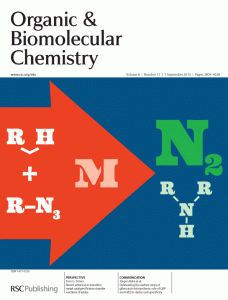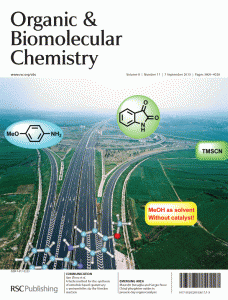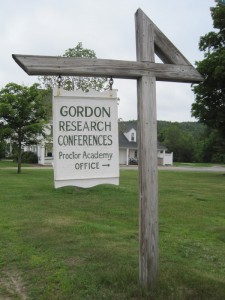‘The BOSS-conference is a unique international symposium’– this is written on the BOSS XII web page and after having been there I concur!
The 12th Belgian Organic Synthesis Symposium was held in Namur (Belgium). This is a biennial meeting that attracts researchers, mostly graduate students and post-docs, from all over the globe, especially Europe.
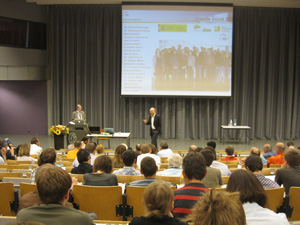
Young rising stars and established organic chemists, a brilliant lecture delivered by Eric Jacobsen(Harvard University), the recipient of the “Janssen Pharmaceutica Prize for Creativity in Organic Synthesis”, and a fantastic one-day course by Professor David MacMillan (Princeton University), Editor-in-chief of Chemical Science, were the ingredients of the perfect cocktail of this summer.
OBC sponsored a poster prize which was awarded to Kurt Hoogewijs, University of Ghent. Congratulations! We hope you enjoy your prize: a RSC book entitled ‘Eco-Friendly Synthesis of Fine Chemicals’ edited by Roberto Ballini.
I’d also like to congratulate Prof. Manfred T. Reetz (Max Planck, MULHEIM / Ruhr, Germany) and Prof. Stéphane Vincent (FUNDP Namur, Belgium), Chairman and host of BOSS XII, for organising such a superb conference.
Take a look at some recently published papers by some of the speakers of this meeting.
Micro-scale process development of transaminase catalysed reactions
Matthew D. Truppo and Nicholas J. Turner
Org. Biomol. Chem., 2010, 8, 1280-1283
Biosynthesis of the mitochondrial adenine nucleotide translocase (ATPase) inhibitor bongkrekic acid in Burkholderia gladioli
Barbara Rohm, Kirstin Scherlach and Christian Hertweck
Org. Biomol. Chem., 2010, 8, 1520-1522
Towards the synthesis of a Yersinia pestiscell wallpolysaccharide: enantioselective synthesis of an L-glycero-D-manno-heptose building block
Takafumi Ohara, Alexander Adibekian, Davide Esposito, Pierre Stallforth and Peter H. Seeberger
Chem. Commun., 2010, 46, 4106-4108
Ring-opening reaction of Bus- and SES-protected aziridines using lithiated dithianes
Ken Sakakibara and Kyoko Nozaki
Org. Biomol. Chem., 2009, 7, 502-507
Synthesis, photophysical, electrochemical, and electrochemiluminescent properties of 5,15-bis(9-anthracenyl)porphyrin derivatives
Chloè Sooambar, Vincent Troiani, Carlo Bruno, Massimo Marcaccio, Francesco Paolucci, Andrea Listorti, Abdelhalim Belbakra, Nicola Armaroli, Alessandra Magistrato, Rita De Zorzi, Silvano Geremia and Davide Bonifazi
Org. Biomol. Chem., 2009, 7, 2402-2413
Silver-catalysed protodecarboxylation of carboxylic acids
Lukas J. Gooßen, Christophe Linder, Nuria Rodríguez, Paul P. Lange and Andreas Fromm
Chem. Commun., 2009, 7173-7175
Metal-catalyzed rearrangement of enantiomerically pure alkylidenecyclopropane derivatives as a new access to cyclobutenes possessing quaternary stereocenters
Ahmad Masarwa, Alois Fürstner and Ilan Marek
Chem. Commun., 2009, 5760-5762
Stereoselective gold-catalyzed cycloaddition of functionalized ketoenynes: synthesis of (+)-orientalol F
Eloísa Jiménez-Núñez, Kian Molawi and Antonio M. Echavarren
Chem. Commun., 2009, 7327-7329
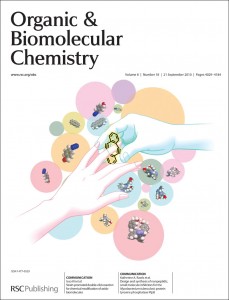 Isao Kii, Takamitsu Hosoya and colleagues modify an azido-biomolecule by a new method that conjugates three molecules spontaneously in a catalyst-free strain-promoted “double-click” (SPDC) reaction.
Isao Kii, Takamitsu Hosoya and colleagues modify an azido-biomolecule by a new method that conjugates three molecules spontaneously in a catalyst-free strain-promoted “double-click” (SPDC) reaction.










